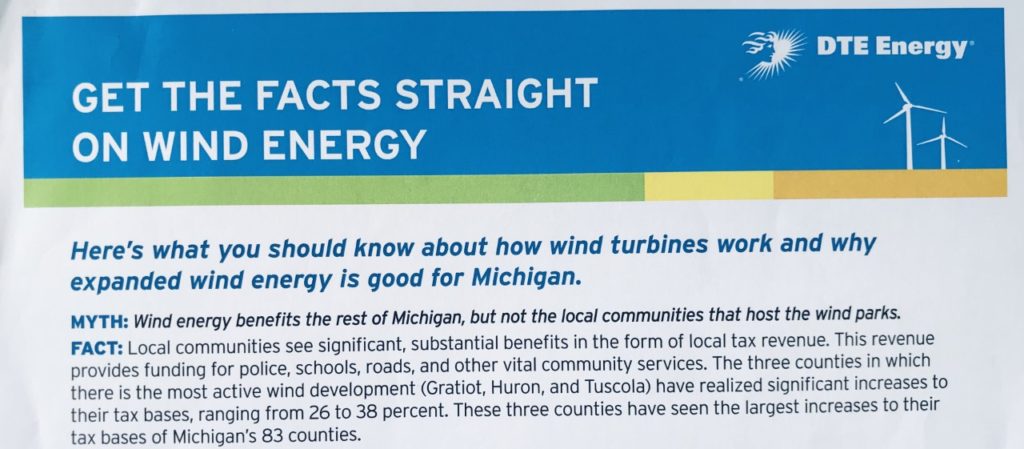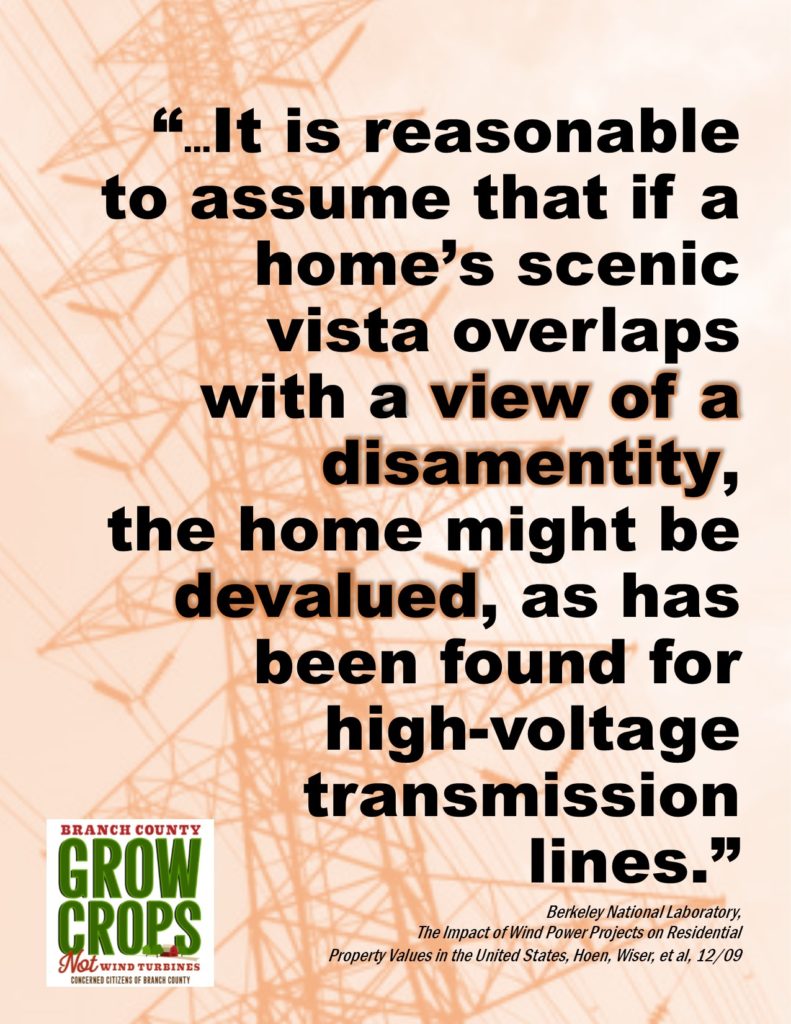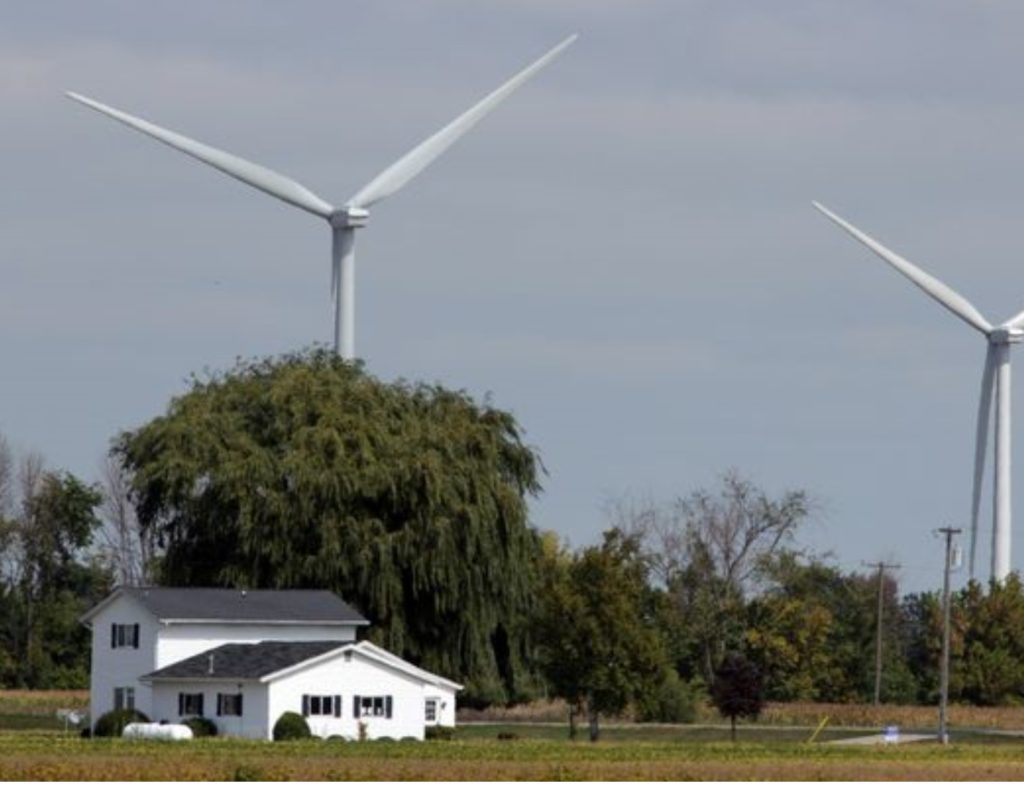The Reality of Industrial Wind in Michigan: Part 1
DTE started leasing land in rural Branch County, Michigan, almost two years ago.
They employed nice guy subcontractors and attorneys to knock on the doors of our neighbors.
They made lots and lots of claims, many of which were simply not true. Their tactics sent up red flags all over our rural community.

Sadly, shady tactics have been the norm for DTE here in Branch County.
One of the few pieces of literature DTE gave out to prospective lease holders was a sheet called, “Get the Facts Straight on Wind Energy.” It says, “Here’s what you should know about how wind turbines work and why expanded wind energy is good for Michigan.”

DTE proceeds to list the various “myths” about wind energy and then shares their version of the “facts.” Unfortunately, the majority of DTE’s “facts” were misleading — and in other cases downright false.
So, when it came time for us to publicly give our rebuttal and share our own concerns, we shared our own review of the information behind DTE’s proposed “facts.” Because there is a third entirely different category: REALITY.
Below are a couple of the rebuttals of DTE’s “facts” — and the reality of Industrial wind in rural Michigan.
Sadly, over the last year, I have learned that when residents of the community question or challenge the assertions of the wind developer, we are labeled, branded or attacked, by DTE, their subcontractors and hired activists. When you advocate for appropriate renewables with appropriate siting, DTE (and its paid posse) attempts to distract from the matter at hand by calling you “anti-wind” or climate deniers. No one is served by their all or nothing tactics — and certainly not rural residents.
The format of the information shared is not meant to be a comprehensive summary of all variables or research. Rather, the information shared is the counterpoint to the limited information DTE is willing to put in writing and share with the public.
How Exactly Does the Community Benefit?
Well, here’s what DTE purports.
MYTH: Wind energy benefits the rest of Michigan, but not the local communities that host the wind parks.
DTE’s FACT: Local communities see significant, substantial benefits in the form of local tax revenue. This revenue provides funding for police, schools, roads, and other vital community services. The three counties in which there is the most active wind development (Gratiot, Huron, and Tuscola) have realized significant increases to their tax bases, ranging from 26 to 38 percent. These three counties have seen the largest increases to their tax bases of Michigan’s 83 counties.

But DTE’s claim does not tell the whole story.
REALITY: “‘(Economic impacts) are really felt by the people with turbines on their property, but not so much by anybody else,’ Mills said, adding that spreading economic benefits more broadly could be a good thing.”
Source: Huron Daily Tribune, Study Tells More of Turbine Impacts, November 19, 2014.
https://www.michigansthumb.com/news/article/Study-tells-more-of-turbine-impacts-7265953.php
REALITY: “As a result, while wind developers have paid millions of dollars of additional tax revenue to rural communities, there has been no discernible improvement in the household budgets of taxpayers throughout these windfarm communities.”
Source: University of Michigan, Preserving Agriculture through Wind Energy Development: A Study of the Social, Economic, and Land Use Effects of Windfarms on Rural Landowners and Their Communities, Mills, S., 2015
https://deepblue.lib.umich.edu/bitstream/handle/2027.42/111508/sbmills_1.pdf?sequence=1&isAllowed=y
REALITY: “We conclude that the entrance of wind development has not affected the budgets of school districts in Michigan. (…) Wind developers should be careful in promoting the benefits to local schools and not overstate the impact of their taxes as they see little to no benefit.”

Source: Panel Paper: Money Blowing Through: The Effect of Wind Development on School Finances; Cannon and Mills, University of Michigan, November 2017
https://appam.confex.com/appam/2017/webprogram/Paper22176.html
REALITY: Large majority of jobs created by wind were temporary construction jobs. Source: Readying Michigan to Make Good Energy Decisions: Renewable Energy, Quackenbush, J., Michigan Public Service Commission, Bakkal, S., Michigan Energy Office, November 4, 2013, p 74. https://www.michigan.gov/documents/energy/renewable_final_438952_7.pdf
Of course landowners receiving direct payments from the wind developer benefit financially — no one is contesting that. But for DTE to imply that this financial prosperity somehow trickles down to all rural residents in the community is simply deceiving.
Your HOME is Your Castle
One of the first concerns that my neighbors and I had was what would the proposed turbines do to our property values. Yet DTE says there’s no negative impact — they even throw out some numbers showing huge financial increases as proof.
MYTH: The presence of wind parks lowers property values.
DTE’s FACT: A number of studies in the US and Canada find no negative impact on property values or even an increase in property values. In Huron County, the personal property class went from $307 million to $559 million between 2013-2014 – an 82 percent increase. From 2014 to 2015, that $559 million gained about 10 percent, to $614 million. Source: Allan Chen, No Evidence of Residential Property Value Impacts Near US Wind Turbines, A New Berkeley Lab Study Finds Berkeley Lab, 8/27/13

So I started digging into these sources that DTE shared. What I found was alarming.
REALITY: The Berkeley Lab study included sales that were up to 10 miles away from an IWT. But researchers in Wisconsin find that is too big of a data pool. “Casting too wide a net creates risk of missing the real effect IWTs has on property values.”
Source: Study of Wind Energy Development in Wisconsin: A Collaborative Report, Energy Center of Wisconsin July 1, 2004, p. 137. https://visionpdf.com/a-study-of-wind-energy-development-in-wisconsinb02b6dcbda7fc33cd0f9f66ddd41812b15104.html
REALITY: The Berkeley Lab study reported that “aesthetics and property values are intrinsically linked” and that “it is reasonable to assume that if a home’s scenic vista overlaps with a view of a disamenity, the home might be devalued, as has been found for high voltage transmission lines.”

Hmm.
Aesthetics and property values are intrinsically linked.
So then, why isn’t it reasonable to assume that if a house’s scenic vista overlaps with a 500-600′ tall turbine, it too might be devalued??
Not exactly rocket science.
But even more concerning, when you read the footnotes of the Berkeley Lab study you discover a few troubling tidbits:
- one, how much data was discarded because the homes were sold twice within a 6 month period;
- two, how much data was discarded because the sale price was too far away from the statistical mean;
- and three, perhaps most alarming of all — that the researchers flat out discarded the data of the homes that were purchased by the wind developers.
Now I am clearly not a statistician, but if the presence of the turbines resulted in a uncharacteristically low sale price, why would researchers choose to reject that data — data that came directly from the local municipalities as actual sales data? If you are truly trying to objectively assess what the presence of a turbine does to the value of a home, how can you rationalize not including home sales that the developers had to make? From this rural resident’s perspective, that is an epic fail.
Please digest those footnotes for a moment.
Researchers from the Berkeley Lab did not include data from homes purchased by the wind developer in their analysis. They discarded it. Rejected it. Threw it out.
Then, those same Einsteins discarded all the sales data that they felt was too far outside the mean, labeling it not applicable, even though it was data provided by the municipalities. Couldn’t it have been that the data was significantly off the mean because the house value plummeted due to the close proximity of the turbine?
Yet the researchers concluded that, “One might, however, reasonably expect that the property values of these homes were impacted by the presence of the wind turbines.”
The devil is in the details.
Now let’s go back and and take a closer look at those numbers that DTE listed to support their claim of property values not being impacted by the presence of turbines in Huron County, well — we discover something else completely misleading. They said Huron County had an 82% increase — from $307 million to $559 million in personal property class.
REALITY: DTE is talking about “property values” yet they show monetary figures for “Personal Property Class” values from Huron County.
Personal Property Class is machinery & equipment, including wind energy systems as personal property class. Source: Michigan State Tax Commission, MCL 211.34c (3)(c)
Why is DTE using personal property class data — reflective of the value of THEIR turbines — to support their claim that turbines won’t lower my property value?
Nicely put, that’s apples to stinkin’ oranges. Rotten stinkin’ oranges.

Or worse, it’s a conman’s shell game. A con that is wagering the house that our rural community won’t be able to discern the hogwash from the truth.
Pretty sure the fact-checkers at DTE would know the definition of personal property class.
So what genius at DTE thought showing personal property class numbers to support property values was a good idea? Or, is it that DTE knows exactly how absurd it is to show the value of their turbines as an example to support their proposition that turbines don’t negatively impact rural homes — and they did it anyway.
REALITY: 45% of landowners surveyed in the Thumb agreed or strongly agreed that Wind Turbines reduce nearby property values.
Preserving Agriculture through Wind Energy Development: A Study of the Social, Economic, and Land Use Effects of Windfarms on Rural Landowners and Their Communities, Mills, 2015. p.27.

Almost half of the people surveyed, who live in the Thumb, believe that the presence of turbines reduces nearby property values.
I put my bet on the opinions of my rural counterparts to the north over the data-throwing-out-researchers at Berkeley all day long. Common stinkin’ sense.
A funny thing happens when you call realtors in the Thumb.
You hear the words “unmarketable” and “unsellable.”

You are given examples of homes that took huge hits because of being within the shadow of a turbine. (And hey, the Department of Energy’s Office of Energy Efficiency & Renewable Energy, says that shadow flicker “can only be seen from a distance of less than 1,400 meters from the turbine at certain seasons and times of day.” Only. Ooookay, so that’s approximately 9/10ths of a mile.)
One of the most basic, common sense perspectives I came across, while researching this issue, belonged to a Shiawassee County Commissioner, by the name of Mike Bruff. Mike also happens to be a real estate agent. He said, “It’s common sense. I’m absolutely 100 percent positive that a client will never tell me, ‘Please show me a nice house near a wind turbine.’ In the real estate world, we don’t track non-sales, we track sales. There are no studies of non-sales.”
Exactly.
However if one still needs more to go on, there are resources NOT tied to the wind industry which have looked at sales data.
REALITY: There are numerous studies, both domestic & abroad, which analyzed data from real estate transactions in closer proximity to IWTs and found a significant negative impact on property values.
Source: Heintzelman & Tuttle, Clarkson University, 2011; Lansink.ca/downloads Case Study Diminution In Value Injurious Affection Wind Turbines.pdf;
Pharos Tribune, Wind and Worth, January 13, 2018.
http://www.lansinkappraisals.com/downloads/CaseStudy_DiminutionInValue_InjuriousAffection_WindTurbines.pdf
https://www.researchgate.net/publication/228267728_Values_in_the_Wind_A_Hedonic_Analysis_of_Wind_Power_Facilities
https://docs.wind-watch.org/AGO-WIND-TURBINE-IMPACT-STUDY.pdf
https://www.pharostribune.com/news/local_news/article_423ce606-f89e-11e7-a8b6-bbefcbd3c4c3.html
The Truth Matters
The more I dissected DTE’s facts, the more miffed I got.
Who signed off on these “facts” that were being handed out to my friends and neighbors?
Talk about shady.
In that same myth and fact sheet, DTE says that “energy companies work hard to be good tenants and neighbors in the communities where they have wind parks.”
That’s baloney.
Good tenants and neighbors don’t mislead and deceive in order to get what they want.

You can read more about DTE’s “Facts” in Part 2 of this saga about the reality of Industrial Wind. Thanks for reading and thanks for fighting alongside us as we advocate for our health, welfare and safety.
Peace and love from our dirt road farm.